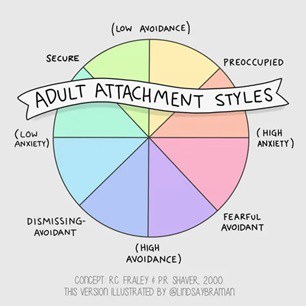Attachment as Life Long Forcefield II
19 November 2022
Last week we ended with a description, from the Vancouver M.D. Gabor Maté, of the role of stressors in the relationship between a parent (or primary caregiver) and an infant. The word usually associated with that relationship is attachment. Holmes (2015, p. 209) defines attachment as “…the reciprocity upon which individuals’ survival, developmental progress, and emotional flourishing depend. Intimate relationships are typically those between parents and children, spouses, close siblings, [and] sporting or military ‘buddies’...” In this blog we look at the varieties of attachment.
In broad terms, people are securely or insecurely attached. Within the insecure division are three types of attachment, as illustrated in Figure 1. Secure attachment is characterized as leaving a person “self-assured, direct, responsive” while preoccupied attachment is described as “self-doubting, anxious, sensitive.” Moving clockwise, through the illustration, the third attachment style is fearful avoidant, self-sabotaging, unpredictable, and isolated while the fourth is dismissive avoidant, “self-reliant, avoidant, and distant.” (The diagram uses “dismissing” which is more frequently described as “dismissive” hence my substitution.)
On that note, I’ll provide a (frustrated) warning to those of you who may begin to use these terms. From my brief survey of the literature, mental health researchers are far from agreement on the terminology describing the three insecure styles but more consistent regarding the clustered attributes of the three styles. I’ve used the terms in Figure 1 and bracketed some of the other parallel labels, hoping that helps.

From Figure 1, above, the primary axes are the horizontal and vertical dimensions which are anxiety and avoidance, respectively. Using the four quadrants, high anxiety with high avoidance, results in a personality considered fearful avoidant. If low on avoidance with low anxiety, secure would be the attachment style associated with that personality. We’ll look at all four. What’s interesting is the shadows these styles are thought to cast over our entire lives. Let’s begin at the upper right with preoccupied attachment.
Anxious Preoccupied (Anxious ambivalent)
The Attachment Project (2022) characterizes this style as the result of “...misattuned and inconsistent parenting.” If your parents (or primary caregiver) didn’t understand your emotional/social responses and needs, they were misattuned to you. If one day they responded responsibly but on other days were frequently unavailable, they parented inconsistently. The prime characteristics of the anxious preoccupied attachment style are “low self-esteem, strong fear of rejection or abandonment, and clinginess in relationships.”
Fearful/Avoidant (Disorganized)
Fearful/avoidance arises from fear of caregivers. The reasons behind such fear frequently include abuse and trauma (The Attachment Project). Fearful avoidance can appear to outsiders as inconsistent behaviours. Manifestations can look like depression, borderline personality disorder, and/or substance use disorders.
Imagine the terror of that child whose source of nurturance and love has become a primary source of fear. That’s a hard road. And it’s hard on those who, in later life, love them. Because the fearful/avoidant attachment style includes parts of both anxiousness and avoidance, these people seek to love and to be loved—and then they don’t.
The root is the doubly charged forcefield they experienced in youth. By reaching out to the parent they loved and needed, they met with fear or worse. Their ability to trust is weak. From my small knowledge of these styles, my guess is that you might recognize the fearful/avoidant person through inconsistency, the avoidant dismissive through their ability to close down, and the anxious/preoccupied through clinginess and fear of abandonment.
Avoidant (Avoidant-Dismissive)
The parenting characteristics leading to avoidant/dismissive attachment are strictness, low emotional responses, with an expectation that their children are tough and independent. Sadly, the comment on how such people act in relationships is that they won’t let you in. You stay on the surface while they protect their wounded interiors. Their tendency to close down personally, and to end relationships rather than letting them deepen, is thought to arise from the inability, in youth, to find a responsive, caring parent. As lovers, they’re distant, and as parents they distance themselves, once again, to avoid being hurt while propagating the pain through another generation. In organized contexts, they tend to be the lone wolves.
Secure Attachment
These fortunate souls (66% of the U.S. population per The Attachment Project) are unafraid of abandonment, faithful, reliable, and well liked. They are described as “…self-contented, social, warm, and easy to connect to.” These characteristics arise from a trusting and consistent relationship with a parent, caregiver, or parents from the earliest sentient moments.
According to the sources consulted, all attachment styles can be changed for the better or worse. But it ain’t easy because we entrench these responses. As such, a high level of self-awareness and a strong willingness to take emotional chances is required not to mention a good, reliable therapeutic agent.
That’s attachment or my current knowledge of the phenomenon. Based on a recent thread of tweets, we’ll look at the source of many attachment challenges: emotionally immature parents.
Dan Chalykoff is a supervised psychotherapist working toward an M.Ed. in Counselling Psychology and accreditation in Professional Addiction Studies. He works at CMHA-Hamilton where his primary focus is trauma. He writes these blogs to increase (and share) his own evolving understanding of ideas. Since 2017, he has facilitated two voluntary weekly group meetings of SMART Recovery. Please email him (danchalykoff@hotmail.com) to be added to or removed from the Bcc’d emailing list.
References
The Attachment Project, https://www.attachmentproject.com/about/
Cherry, K. (2022, 26 May). The Different Types of Attachment Styles. Verywellmind. https://www.verywellmind.com/attachment-styles-2795344
Holmes, J. (2015). Attachment theory in clinical practice: A personal account. British Journal of Psychotherapy 31, 2, 208-228.
Comments